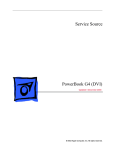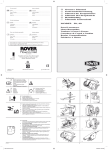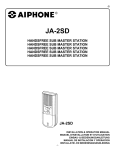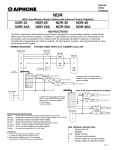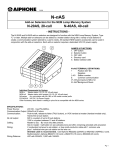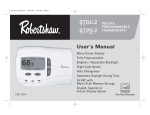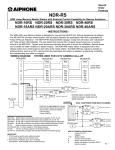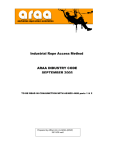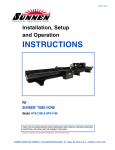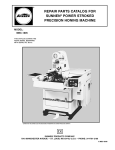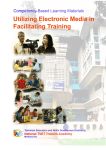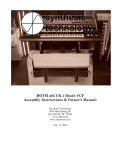Download Audioscope 3 Screening Audiometer Service Manual
Transcript
® Service Manual AudioScope™/ AudioScope 3™ Screening Audiometers Single Hearing Level Models: 23020, 23000, 23040 Three Hearing Level Model 23300 Charging Stand 71123 Charging Transformers: Australia - 71036, Europe - 71032, Japan -71030, United Kingdom 71034, United States - 71040 PN: 230260 Rev. B Welch Allyn, Inc. 4341 State Street Road P.O. Box 220 Skaneateles Falls, NY 13153-0220 Copyright 2004 __________________________________________________________________________ Revision History ECN#/ ECO# Date Section Title Author Description 5/31/96 1 General Info. RJS Intro of Document A 5/31/96 2 Service RJS Intro of Document A 5/31/96 3 Troubleshooting RJS Intro of Document A 5/31/96 4 Disassembly/Rep air RJS Intro of Document A 5/31/96 5 Drawings/Specs. RJS Intro of Document B 6/17/04 Soldering BSW Added Soldering Temperatures Revision 5-32904 A 5-32904 5-32904 5-32904 5-32904 1001574 Drawings and/or illustrations and/or part numbers in this document are for reference only. For the most current revision call the Welch Allyn Customer Service phone number listed in Section 1. - 3 - ______________________________________________________________________________________ Table of Contents Cover Page Revision Page Table of Contents Sub Sect SECTION 1: General Information To Service Personnel Limited Warranty Introduction to AudioScopes Figure 1.3 AudioScope Handle Controls Basic System Description (Fig.1.4a Basic System) Basic System Description (charging stand) Use of the AudioScope (Screening) Operating Program 1-Lev (Fig 1.6 Block Diagram) Operating Program 3-Lev (s/n<=969999) ASIC Operating Program 3-Lev (s/n>=970000)nonASIC Technical Functional Specifications (All Models) Pg. 1 3 4-5 1.1 1.2 1.3 1.3 1.4a 1.4b 1.5 1.6 1.7a 1.7b 1.8 7 8 9-11 11 12 12 13-14 15-17 18-20 21-22 23 2.1 2.2 2.3a 25 26 27-28 2.3b 29 2.3c 2.4 2.5 2.5 2.6 2.7 30 31 32-33 32 34-35 36-37 SECTION 3: Troubleshooting 23300 Troubleshooting AudioScope 3 s/n <=969999 Troubleshooting AudioScope 3 s/n >=970000 3.1 3.2 39 40 SECTION 4: Disassembly and Repair, AudioScope 3 Handle Charging stand 4.1 4.2 43-45 46 SECTION 2: Service Intent of Service Manual Repair Parts for AudioScope Lists of Tools/Fixtures/Documents for Service Fig. 2.3b Tools/Fixtures Setup for Calibration for AudioScope and AudioScope 3 s/n<=969999 Fig. 2.3c Tools/Fixtures Setup for Calibration for AudioScope 3 s/n>=970000 Training Calibration (Single Level 23020,23000,23040) Figure 2.5.4 Sound Tube Placement/Adjustment Calibration (Multi Level 23300) s/n <=969999 Calibration (Multi Level 23300) s/n >=970000 - 4 - ____________________________________________________________________________________ Table of Contents conti nued SECTION 5: Drawings/ Test Specifications Manilla Pockets contain 17" x 22" drawings. 5.1 Drawing# Description A02030 A00277 A00984 A00273 A00273 A00985 A01825 Repair Calibration Spec. for AudioScope II Audiometer Handle Test Specifications P.C.B. Test Spec AudioScope II Electronics Module Test Specification Electronics Module Test Specification Audio Module III Test Spec AudioScope III Sound Equipment Calibration and Setup Charging Stand Electrical Test Spec. Audio II Schematic (PCB for ASIC version) PC Board Ass'y (for ASIC version PCB Schematic (for Microcontroller version) A00942 230230 230215 236630 49 Original Size/#sheets B/1 of 1 D/1 of 1 D/1 of 1 D/1 of 2 D/2 of 2 D/1 of 1 C/1 of 1 A/1 of 1 D/1 of 1 D/1 of 1 B Parts catalog pages 230137-3 230237-1 711408-2 Nos.23000, 23020, 23040 AudioScope No. 23300 AudioScope II and 3 No. 71123 Charging Stand A/1 of 1 A/1 of 1 A/1 of 1 - 5 - Section 1: General Information ____________________________________________________________________________________ 1.1 To Service Personnel Read and understand the AudioScope operating instructions manual pn. 2302312. The information in this Service Manual is subject to change without notice and should not be construed as a commitment by Welch Allyn. Welch Allyn assumes no responsibility for any errors that may appear in this manual. Who to contact: If the product and/or its operation varies significantly from any description therein, please contact: Welch Allyn Medical Products Division Product Service Department, 4341 State Street Road, Skaneateles Falls, NY, 13153-0220, U.S.A. Phone (315) 685-4445, or (800) 669-9771. Fax (315) 685-4653 This product has been designed to provide a high degree of safety and reliability. However, we cannot guarantee against the deterioration of components due to aging and normal wear. All service and repairs must be done by authorized Welch Allyn personnel or agents, using approved Welch Allyn replacement parts and approved process materials. Failure to do so will invalidate the product warranty. Please refer to the product warranty for specific coverage. USING ADHESIVES: ALWAYS WEAR SAFETY GLASSES AND PROVIDE ADEQUATE VENTILATION WHEN USING CA ADHESIVES, CA ACCELERATORS, AND RTV ADHESIVE SEALANTS. READ AND OBEY WARNINGS, CAUTIONS, INSTRUCTIONS, AND RECOMMENDATIONS PRINTED ON CONTAINER AND CORRESPONDING MSDS SHEETS CAUTION: PRIOR TO DOING REPAIR WORK, UNPLUG POWER CORD ON CHARGER TO ELIMINATE SHOCK HAZARD. USE GROUNDING MAT AND GROUNDING STRAP TO REDUCE CHANCES OF DAMAGE TO ASIC IN HANDLE. - 7 - ______________________________________________________________________ 1.2 Limited Warranty Welch Allyn warrants the AudioScope, when new, to be free of defects in material and workmanship and to perform in accordance with the manufacturer's specifications for a period of one year from the date of purchase from Welch Allyn or its authorized distributors or agents. Welch Allyn will either repair, replace or recalibrate any components (except lamps) found to be defective or at variance from the manufacturer's specifications within this time at no cost to the customer, except for transportation expenses. For rechargeable batteries, warranty is extended to two years. It shall be the purchaser's responsibility to return the instrument directly to Welch Allyn or to an authorized distributor, agent or service representative. This warranty does not include breakage or failure due to tampering, misuse, neglect, accidents, modification or shipping. This warranty is also void if the instrument is not used in accordance with the manufacturer's recommendations or if repaired by other than a Welch Allyn or authorized agent. This warranty can be extended to a three-year period provided the instrument is returned for recalibration annually. Submission of instrument registration card is required. Purchase date determines warranty and recalibration requirements. No other express warranty is given. To receive service assistance or to ask questions regarding this warranty, please call or write: Welch Allyn Product Service Dept. Welch Allyn, Inc. Medical Products Division 4341 State Street Road Skaneateles Falls, New York 13153 USA 1 (800) 669-9771 or (315) 685-4445 Note: The U.S. Occupational Safety and Health Administration (OSHA) recommends that audiometers be calibrated annually. Arrangements for calibration can be made by returning the instrument registration card. In addition a daily biological check may be performed. This is accomplished by a person with known normal hearing who listens to the tones for intensity and quality. There is a moderate fee for recalibration. *Re-printed from PN230108, Instrument Registration Card - 8 - ___________________________________________________________________ 1.3 Introduction to AudioScopes The Welch Allyn AudioScope (audiometer) enables the practitioner to perform a fast, painless and objective test for early hearing loss. The AudioScope3 starts with a Practice Tone (PT) of 1,000 Hz at a dB HL dependent upon the selected Screening dB HL.(Refer to Page 5 of Operating Instructions). After the Practice Tone (PT), the AudioScope3 provides screening at all four speech frequencies: 1,000 Hz, 2,000 Hz, 4,000 Hz, and 500 Hz. This test can be performed at one of three hearing levels: 20 dB, 25 dB, or 40 dB. Selection of the hearing level is dependent on the age of the patient. Note: there is no PT with single level AudioScopes. If a hearing problem is suspected, the patient is referred to a specialist for diagnosis. The AudioScope contains a 3.5-volt halogen lamp and otoscope lens for viewing the tympanic membrane and the ear canal prior to and during hearing screening. There are two types of Welch Allyn AudioScopes in use today: • The first type is the single hearing level instrument of which there are three models. Although they are obsolete, they can still be calibrated if they are functioning according to specifications. Service parts are not available. AudioScope pn 23020 - 20 dB (no PT) AudioScope pn 23000 - 25 dB (no PT) AudioScope pn 23040 - 40 dB (no PT) • The second type is the three hearing level (MultiLevel) AudioScope3. (Also known as AudioScope II) There are two versions of this second type. AudioScope3 pn 23300 - 20, 25, 40 dB (1000 Hz PT) The original version of the AudioScope 3 (three hearing level) up to and including serial number 969999 utilizes an ASIC module. This instrument is calibrated by adjusting miniature potentiometers on the printed circuit board. Although the main board/ASIC is being phased out at the time of this writing, they can still be calibrated if they are functioning according to specifications. Some parts are available. (See Repair Parts, Section 2.2) NEW VERSION: A new version (starting in 1996 with serial number 967000) differs from the first AudioScope3 in that a Microcontroller is used instead of the ASIC. Performance specifications of the new AudioScope 3 are identical to the earlier AudioScope 3, and the part number remains the same. Since this version utilizes a Microcontroller with digitally adjusted pots and not mechanical potentiometers, calibration is much easier. Tool T-13765 is used to electronically adjust the board. This advance eliminates the limitations of mechanical potentiometers and reduces calibration time. - 9 - __________________________________________________________________________ 1.3 Introduction to AudioScopes The operation and calibration of all five of these screening audiometers are explained in this manual. Important note to Service Personnel Board Replacement on AudioScope 3: Welch Allyn manufactures only the AudioScope3 as of Oct. 1986. As of 1996, starting with serial no.967000 a new version AudioScope3 utilizes a Microcontroller (does not have ASIC) and is calibrated using the T-13765 Calibrator Box. It has digital potentiometers for calibration, not mechanical pots. All previous models were calibrated using mechanical potentiometer. Calibration of all types of AudioScopes is explained in this manual. If the ASIC fails on an AudioScope 3, the whole board will be replaced with the new board containing the digitally adjustable Microcontroller. This board will fit the AudioScope3 with no modifications. Unit performance is the same. Obsolescence of Single Level AudioScope: Single Level AudioScopes are over ten years old. Service Parts are not available. Recalibrations CAN be performed on properly functioning single level AudioScopes. For failed units, save the lamp, battery, and charging stand/transformer for use with AudioScope3. - 10 - ____________________________________________________________________ 1.3 Introduction to AudioScopes AudioScope 3 Handle Controls and features are shown in the figure below. - 11 - ____________________________________________________________________ 1.4a Basic System Description There are three components to the Welch Allyn AudioScope: the hand held AudioScope handle, the Charger stand and transformer. 1.4b AudioScope Charging Stand The charging stand holds the handle and specs and is the interface between the Handle and the charging current of the wall transformer. Insertion of the handle into the charging well completes the charging circuit. An LED illuminates when the handle is in the well and the charging circuit is complete. _____________________________________________________________________ 1.5 Use of the AudioScope (Screening) Read pg. 6-8 of Operating Instructions pn230231-2 (shown below) for full details of the screening procedure. Note: The following excerpt is only an outline intended for general familiarization by service personnel. This outline is not intended to replace above referenced Operating Instructions pn 230231-2. 1. Check that lens is centered in the instrument. 2. Select an area that is relatively quiet and free from distracting sounds. See page 26 of Operating Instructions for Maximum Permissible Ambient Noise for the different screening levels. 3. Select appropriate size specula and twist onto instrument. USE ONLY GRAY-TIPPED WELCH ALLYN AUDIOSPECS. - 13 - _____________________________________________________________________ 1.5 Use of the AudioScope (Screening) continued 4. 5. 6. 7. Turn AudioScope3 "ON" by sliding the selection switch to the desired screening level. Instruct patient to respond appropriately to sound. Insert the tip of the speculum into the ear canal. Position the tip so that the tympanic membrane or a portion of it can be visualized. Depress START button and observe each tone and the patient's response. Repeat these steps for opposite ear. Remove instrument from patient's ear and turn off. Return to the Charging stand. (REFER TO Operating Instructions). _______________________________________________________________________ 1.6 Operating Program of Models 23020, 23000, 23040 Single Hearing Level AudioScope NOTE: Since these models of AudioScopes are well over ten years old, the circuitry is no longer available. If this circuitry fails, the Single Level AudioScope is no longer repairable. Recalibrations CAN be performed if the unit is functioning properly. If the unit fails, however, the lamp, battery, and charging stand/transformer can be re-used with the AudioScope3. See Fig. 1-6 Block Diagram of Welch Allyn AudioScope. • SINGLE HEARING LEVEL AudioScope models (20,25,40 dB) use the same basic circuitry except for the value of R 21 and the adjustments on VR2. Model: Ohms of R21: 20 dB AudioScope = 11 Ohms 25 dB AudioScope = 20 Ohms 40 dB AudioScope = 130 Ohms AudioScope Service Manual 1.6 __________________________________________________________________________ 1.6 Operating Program: 23020, 23000, and 23040 Single Hearing Level AudioScope Sequence: 1. Manual Cause: Switch "ON" 2. Manual Press "START" U4 activated 3. Logic pin 11 goes to 0v activates LED (500 Hz LED.) U4 pulls pin 20 to 0v selects resistance between pin 7 of U2 and ground. produces 500 Hz sine wave at pin 2 of U2 this charges C5 U4 also selects resistance between pin 14 of U4 and pin 5 of U3. Effect: Lamp "ON", Ready LED "ON" this resistance is adjusted for the output amplitude of the 500 Hz tone only and is used to control output amplifier U3. (Process repeats for the 1000 Hz, 2000 Hz, and 4000 Hz tones.) 4. Logic pin 4 goes to 0v activates LED (1000 Hz LED.) U4 pulls pin 22 to 0v selects resistance between pins 7 of U2 and ground. produces 1000 Hz sine wave at pin 2 of U2 this charges C5 5. Logic U4 also selects resistance between pin 15 of U4 and pin 5 of U3. this resistance is adjusted for the output amplitude of the 1000 Hz tone only and is used to control output amplifier U3. pin 12 goes to 0v activates LED (2000 Hz LED.) U4 pulls pin 21 to 0v selects resistance between pin 7 of U2 and ground. produces 2000 Hz sine wave at pin 2 of U2 this charges C5 - 16 - __________________________________________________________________________ 1.6 Operating Program: 23020, 23000, 23040 Single Hearing Level AudioScope continued Sequence: Cause: U4 also selects resistance between pin 17 of U4 and pin 5 of U3. Effect: this resistance is adjusted for the output amplitude of the 2000 Hz tone only and is used to control output amplifier U3. 6. Logic pin 3 goes to 0v activates LED (4000 Hz LED.) U4 pulls pin 1 to 0v selects resistance between pin 7 of U2 and ground. produces 4000 Hz sine wave at pin 2 of U2 this charges C5 U4 also selects resistance between pin 16 of U4 and pin 5 of U3. this resistance is adjusted for the output amplitude of the 4000 Hz tone only and is used to control output amplifier U3. 7. Logic cycle completes itself Ready LED illuminates 8. Manual switch off unit deactivates, lamps & logic off - 17 - __________________________________________________________________________ 1.7a Operating Program: 23300 (ASIC TYPE) up to and including serial no.9609999 Multi-Level AudioScope3 ASIC The Three Hearing Level AudioScope3 up to and including Serial Number 960999 uses an ASIC (single application specific integrated circuit) Microprocessor. This component is not a service part. If the ASIC Microprocessor should fail, it will be necessary to replace the Circuit Board/ASIC assembly with the new Microcontroller based circuit board Part No. This is an easy replacement and does not affect unit operation. Calibrate the Microcontroller based AudioScope3 with T-13765 AudioScope Calibrator Box explained in Section 2.7.11 Tone Generation: External resistors and capacitors are used to generate four different tones at hearing levels of 20, 25, 40 dBs. The output amplitude is determined by SW2, which selects one resistor for a hearing level of 20, 25, or 40 dBs respectively. Operation begins with switching the unit ON. The examination halogen lamp illuminates immediately. When the start button is depressed, the AudioScope begins to generate a sequence of tones starting with PT of 1000 Hz, which is 20 dB higher than the manually selected specific hearing level. Then the 1000 Hz, 2000 Hz. , 4000 Hz and 500 Hz tones are generated in that order at the same hearing level. When the cycle is complete, the AudioScopes returns to the ready state indicated by the Green "Ready" LED. The whole cycle is completed in less than 20 seconds. - 18 - __________________________________________________________________________ 1.7a Operating Program: 23300 (ASIC TYPE) up to and including serial no.9609999 Multi-Level AudioScope3 ASIC Sequence: 1. Manual Cause: Switch "ON" Effect: Lamp "ON", Ready LED "ON" 2. Manual Press "START" ASIC activated 3. Logic pin 20 goes low activates PT (PreTone) LED (D6) PreTone 1kHz sine wave appears at ASIC Pin 4 and is amplified and then applied to speaker from ASIC Pin 7 Speaker produces 1 kHz PreTone (General cycle is repeated for TEST tones: 1000 Hz, 2000 Hz, and 4000 Hz and 500 Hz) 4. Logic ASIC Pin 21 goes low 1kHz sine wave appears at ASIC Pin 3 and is amplified and then applied to speaker from ASIC Pin 7 activates 1 kHz LED (D5) Speaker produces 1 kHz Tone 5. Logic ASIC Pin 22 goes low 2kHz sine wave appears at ASIC Pin 6 and is amplified and then applied to speaker from ASIC Pin 7 activates 2 kHz LED (D4) Speaker produces 2 kHz Tone 6. Logic ASIC Pin 23 goes low 4kHz sine wave appears at ASIC Pin 5 and is amplified and then applied to speaker from ASIC Pin 7 activates 4 kHz LED (D3) Speaker produces 4 kHz Tone __________________________________________________________________________ 1.7a Operating Program: 23300 (ASIC TYPE) up to and including serial no.9609999 Multi-Level AudioScope3 ASIC Sequence: 7. Logic Cause: ASIC Pin 24 goes low 500 Hz sine wave appears at ASIC Pin 2 and is amplified and then applied to speaker from ASIC Pin 7 Effect: activates 500 Hz LED (D2) Speaker produces 500 Hz Tone 8. Logic cycle completes itself and activates D1 Ready LED illuminates 9. Manual switch off unit deactivates, lamps & logic off __________________________________________________________________________ 1.7b Operating Program: 23300 (Microcontroller type serial no.9670000 and higher) Multi-Level AudioScope3 (Microcontroller/non ASIC) Sequence: 1. Manual Cause: Switch "ON" 2. Manual Press "START" MICRO activated 3. Logic U4 pin 9 goes to 3 V activates PT (PreTone) LED (D3) 4. Logic U4 pulses pin 4 U4 ramps U5 (digital pot) to calibrated level. This establishes feedback resistance for U3C. U4 sequentially toggles pin 19, 20, 21, 22 Generates digital base amplitude sinewave at pin TP10 Effect: Lamp "ON",Ready LED "ON" General cycle is repeated for TEST tones : 1000, 2000, 4000, and 500 Hz. 5. Logic 6. Logic U4 pin 8 goes to 3 V activates 1000 Hz LED (D4) U4 pulses pin 4 U4 ramps U5 (digital pot) to calibrated level. This establishes feedback resistance for U3C. U4 sequentially toggles pin 19, 20, 21, 22 Generates digital base amplitude sinewave at pin TP10 U4 pin 7 goes to 3 V activates 2000 Hz LED (D5) U4 pulses pin 4 U4 ramps U5 (digital pot) to calibrated level. This establishes feedback resistance for U3C. U4 sequentially toggles pin 19, 20, 21, 22 Generates digital base amplitude sinewave at pin TP10 - 21 - __________________________________________________________________________ 1.7b Operating Program: 23300 (Microcontroller type serial no.9670000 and higher) (continued) Multi-Level AudioScope3 Sequence: 7. Logic (Microcontroller/non ASIC) Cause: U4 pin 6 goes to 3 V Effect: activates 4000 Hz LED (D6) U4 pulses pin 4 U4 ramps U5 (digital pot) to calibrated level. This establishes feedback resistance for U3C. U4 sequentially toggles pin 19, 20, 21, 22 Generates digital base amplitude sinewave at pin TP10 U4 pin 5 goes to 3 V activates 500 Hz LED (D7) U4 pulses pin 4 U4 ramps U5 (digital pot) to calibrated level. This establishes feedback resistance for U3C. U4 sequentially toggles pin 19, 20, 21, 22 Generates digital base amplitude sinewave at pin TP10 9. Logic cycle completes itself and activates D2 Ready LED illuminates 10. Manual switch off unit deactivates, lamps & logic off 8. Logic - 22 - __________________________________________________________________________ 1.8 Technical Specifications • Charging Stand: Model# Application: 71123 Charging Stand for all models of AudioScope Charging Transformers Model#: Application: 71040 USA and Canada 71036 Australia 71032 Europe 71030 Japan 71034 United Kingdom • Handles: Frequencies Distortion - Rise/fall times - Tone duration Pause between tones Sound level - 500, 1000, 2000, 4000 Hz +/- 3% Less than 3% total harmonic distortion as measured at transducer input 20 to 200 msec. as measured between the -1 and -20 dB points 1.5 seconds +/- 0.2 seconds Varied between 1.0 and 2.0 seconds Sound levels were established by threshold loudness balance method to TDH-39 receiver with MX41/AR cushion per ANSI S3.6-1969 Ref. Thresholds. These levels were established in an independent study and are equivalent to standard audiometric headphones. +/- 3 dB @ 500, 1000, and 2000 Hz, +/- 4 dB @ 4000 Hz. This corresponds to the following absolute sound pressure levels when the instrument is coupled to an occluded ear simulator per ANSI Std. No. S3.251979: Freq. 500 1000 2000 4000 For 20 dB HL for 25 dB HL for 40 dB HL 28.2 - 31.6 33.2 - 36.6 48.2 - 51.6 26.3 - 28.3 31.3- 33.3 46.3 - 48.3 31.1 - 34.2 36.2 - 39.2 51.2 - 54.2 32.0 - 35.8 37.0 - 40.8 52.0 - 55.8 Lamp Battery - Continuous use - 3.5v Halogen, 20 hr avg. life 3.5v nickel cadmium rechargeable pn72300 650 mA/hr. 50 minutes (approx) between full charge - 23 - Section 2: Service ______________________________________________________________________ - 24 - 2.1 Intent of Service Manual This manual provides technical assistance to trained service personnel for diagnosing, repairing, calibrating/testing the AudioScope handle and Charging Stand and replacing parts listed in Section 2.2. See the table of contents for a complete listing of manual contents. Welch Allyn part numbers (PN#), and material numbers (M#), appearing in this manual are current at the date of publication. Order replacement parts by referencing your latest bill of materials or parts catalog. Part number changes, product updates, or new test procedures should be noted on the appropriate page of this manual by the manual owner. Notices announcing these changes should be attached to the manual. Caution: prior to doing repair work, unplug power cord on charger to eliminate shock hazard. Use grounding mat and grounding strap to reduce chances of damage to ASIC in handle. Caution when using adhesives: Always wear safety glasses and provide adequate ventilation when using adhesives, accelerators, and RTV adhesive sealants. Read and follow all appropriate recommendations in corresponding MSDS sheets. ______________________________________________________________________ - 25 - 2.2 Repair Parts for AudioScopes Note: Order parts from most recent Bill of Materials/Repair: The attached bill of materials shows replacement parts, which are available from Welch Allyn. Part number 711427-501 711413 711419-501 711418-501 711421 711420 230035-2 230038 230029-1 200055-502 230073-505 230080-502 230201-501 710205 72300 06200 Description Housing assembly Charging stand Holder f/handle & specula Rubber feet (set of 4) Base plate assembly Mounting hardware kit #6 x 3/4 PHPS HD screw self tap Miniature transducer Transducer boot Stabilizing grommet Lens holder assembly Housing assembly Cover assembly Electronics module assembly AS3* Power jack 3.5-volt rechargeable battery 3.5-volt halogen lamp *Single level AudioScope modules pn 230001-501 are No longer Available. - 26 - _____________________________________________________________________ 2.3a Lists of Tools/Fixtures/Documents for Service and Calibration* * The U.S. Occupational Safety and Health Administration (OSHA) recommends that audiometers be calibrated annually. Arrangements for calibration can be made by returning the instrument registration card. In addition a daily biological check may be performed. This is accomplished by a person with known normal hearing who listens to the tones for intensity and quality. There is a moderate fee for recalibration. Properly trained technicians will need specialized commercially available test equipment, custom made (Welch Allyn T-tools) specialized tools and fixtures, basic electronic hand tools and Welch Allyn specifications and drawings to properly diagnose, calibrate, and repair the AudioScope and charger base. Item description: B&K 2231 Modular Precision Sound Level Meter B&K 4134 1/2" Microphone B&K 1625 1/3 to 1 Filter B&K Power Supply (6 V.D.C.) Knowles DB100-R 496 Occluded Ear Simulator Knowles DB-009 Teflon washers Fluke 1900A Frequency Counter (3% accuracy) Oscilloscope Tektronix 2230A or Equiv. (storage type) ESD mat and wrist-strap Electronic Technicians hand tools kit Digital Volt Ohm Meter PACE Soldering Equipment* *Set iron to 700ºF +/- 27ºF Rosin Core Solder, .020", 63Sn/37Pb G.E. RTV 108 (Clear/Thick) Power Supply (0 - 5 VDC @ 1 Amp) AudioScope Holding Device Coupling Tool for Microphone Latchup Box for AudioScope 1 and AudioScope3 with ASIC s/n <=969999 Microphone Handle Cover Function: T #&M# Measures sound output Sound pick-up Acoustic filter Powers B&K 2231 Connects T-1393 and T-2011 Seals microphone and DB-100 connection Calibration and testing Calibration and testing Repair General Repair Troubleshooting/Repair Repair Repair M-31446 Repair M-30313 Testing T-3769 holds AudioScope T-1539 Holds AS to DB-100 assembly T-1393 Holds Tones Holds Microphone to DB-100 AudioScope Calibrator for Microcontroller digital adjust (non ASIC) Charging jack pin-spanner T19102-2 T-9783 T-2011 T-13765 charging jack ring nut tool T-10912 - 27 - __________________________________________________________________________ 2.3a Lists of Tools/Fixtures/Documents for Service and Calibration* Drawing# Description A02030 A00277 A00984 A00273 A00273 A00985 A01825 Repair Calibration Spec. for AudioScope II B/1 of 1 Audiometer Handle Test Specifications D/1 of 1 P.C.B. Test Spec AudioScope II D/1 of 1 Electronics Module Test Specification D/1 of 2 Electronics Module Test Specification D/2 of 2 Audio Module III Test Spec D/1 of 1 AudioScope III Sound Equipment Calibration and Setup C/1 of 1 Charging Stand Electrical Test Spec. A/1 of 1 Audio II Schematic (PCB for ASIC version) D/1 of 1 D/1 of 1 PC Board Ass'y (for ASIC version PCB Schematic (for Microcontroller version) B A00942 230230 230215 236630 Size/# sheets Parts catalog pages 230137-3 230237-1 711408-2 Nos.23000,23020,23040 AudioScope A/1 of 1 No. 23300 AudioScope II and 3 A/1 of 1 No. 71123 Charging Stand A/1 of 1 ___________________________________________________________________ 2.3b Tools and Fixtures Setup for Calibration AudioScope and AudioScope 3 s/n<=969999 (ASIC) Figure 2.3b Calibration Set-up for AudioScopes with ASIC - 29 - _____________________________________________________________________ 2.3c Tools and Fixtures Setup for Calibration AudioScope 3 s/n >=970000 (Microcontroller) __________________________________________________________________________ 2.4 Training The AudioScope is a sophisticated audiometric device and must be serviced and calibrated by trained. They must possess demonstrated skills in this area using specialized and calibrated sound measuring equipment. This Service Manual is the basis for delivering competencybased skills training to technicians or service engineers who already possess knowledge and skills in the use of electronic equipment as listed in the specialized test equipment Section 2.3. They must also be able to properly use certain commercially available equipment and hand tools for diagnosis, calibration, assembly, and board level repairs of the AudioScope and charger base. See Fig.2.3 This manual provides specific information for diagnosing, repairing, calibrating and testing the AudioScope handle and Charging Stand. Refer to the Table of Contents for complete information on the manual. Use this manual for Self Training. Have an AudioScope system on hand to help with familiarization and repair practice. Read each complete repair step before starting hands-on practice. Use this manual for Group Training. The technician will acquire and retain service information and service skills for the AudioScope product because of well prepared and executed training sessions. Conduct detailed demonstrations of required repair tasks then allow time for supervised practice. Set up sessions to allow the trainee time to individually practice all repair procedures. Evaluate trainee progress by observing trainee performance and then recording it on the appropriate form. Each trainee must have the opportunity to practice the procedure(s) after the instructor has demonstrated it. • • Tell them how and why. • Show them how with explanations. • Provide for supervised practice by the trainees. Record results and conduct follow-up training as necessary. - 31 - _________________________________________________________________________ 2.5 Calibration Procedure: Single Level AudioScope • Incoming bench checks: Prepare the AudioScope for calibration. 2.5.1 ___ Check the tightness of the two slotted screws near battery positive spring 2.5.2 ___ Check the tightness of the charger jack 2.5.3 ___ Remove RTV from the potentiometers 2.5.4 ___ Check that the sound tube extends at least 1/16" to 1/8" into the cavity behind the lens. If it does not, move it upwards. Use fingers. Long nose pliers could bend or crush the sound tube See Figure 2.5.4 below • Preparation of Sound Equipment: 2.5.5 ___ Set up your sound equipment as per “AudioScope II Sound Equipment Calibration and Setup Procedure A01825" _________________________________________________________________________ 2.5 Calibration Procedure: Single Level AudioScope • Calibration: Materials Required: Audiometer Handle Test specification A00277 1 sheet (This is the process.) Electronics Module Test Specification, A00273 2 sheets (These are the specifications.) Note :A note appearing on the specification reads"Exact Measurements are not required for 100% inspection". This note does not apply to sound settings. Adjust the AudioScope according to the printed sound settings and their tolerances as shown on the print. Your Sequence: Original Step number from A00277: Modifications if any: step 1 Start Button Check for smooth operation. step 2 On/Off Switch • 2.5.6 ____ • 2.5.6 ____ • 2.5.7 ____ step 3 L.E.D.s • 2.5.8 ____ step 4 Rattle • 2.5.9 ____ step 7 Cover • 2.5.10____ step 8 Pneumatic Seal • 2.5.11____ step 5 Sound Level • 2.5.12____ step 9 Charge • 2.5.13____ step 10 Lamp Ejector • 2.5.14____ step 11 Trained Listener LED.s must be bright. Check seal before sound. Calibration is complete. If Single level AudioScope does not take calibration, unit is not serviceable. Customer should be advised that unit is obsolete, parts are not available . Lamp, battery, and charging system can be used on new AudioScope 3. - 33 - ______________________________________________________________________ 2.6 Multi Level AudioScopes (AudioScope#) 23300 (ASIC TYPE) up to and including serial no.9609999 • Incoming bench checks: Prepare the AudioScope for calibration. 2.6.1 ___ Check the tightness of the two slotted screws near battery positive spring 2.6.2 ___ Check the tightness of the charger jack 2.6.3 ___ Remove RTV from the potentiometers 2.6.4 ___ Check that the sound tube extends at least 1/16" to 1/8" into the cavity behind the lens. If it does not, move it upwards with long nose pliers taking care not to bend or crush the sound tube. See Figure 2.5.4 • Preparation of Sound Equipment: 2.6.5 ___ Set up your sound equipment as per "AudioScope II Sound Equipment Calibration and Setup Procedure A01825" • Calibration: Materials Required: Audiometer Handle Test Specifications A00277 1 sheet (This is the process.) Electronics Module Test Specification, A00985 1 sheet (These are the specifications.) Note: A note appearing on the specification reads “Exact Measurements are not required for 100% inspection". This note does not apply to sound settings. Adjust the AudioScope according to the printed sound settings and their tolerances as shown on the print. Sequence: • Original Step number from A00277: Modifications if any: 2.6.6 ____ step t1 Start Button Check for smooth operation. 2.6.7 ____ step t2 On/Off Switch • 2.6.8 ____ step 3 L.E.D.s • 2.6.9 ____ step 4 Rattle • 2.6.10____ step 7 Cover • 2.6.11____ step 8 Pneumatic Seal • 2.6.12____ step 5 Sound Level • 2.6.13____ step 9 Charge • LED.s must be bright. Check seal before sound. - 34 - ______________________________________________________________________ 2.6 Multi Level AudioScopes 23300 (ASIC TYPE) up to and including serial no.9609999 • Calibration: Continued Sequence: Original Step number from A00277: Modifications if any: • 2.6.14____ step 10 Lamp Ejector • 2.6.15____ step 11 Trained Listener Calibration is complete. If AudioScope3 (ASIC) does not take calibration, proceed to troubleshooting section. After repair of the AudioScope3, calibrate. If the unit cannot be repaired, replace the failed AudioScope 3 ASIC board with a new style Microcontroller based board and calibrate it according to instructions in Section 2.7. - 35 - __________________________________________________________________________ 2.7 Calibration Procedure, Multi Level AudioScopes 23300 (MICROCONTROLLER type, serial no.9670000 and higher) • Incoming bench checks: Prepare the AudioScope 3 for calibration. 2.7.1 ___ Check the tightness of the two slotted screws near battery positive spring. 2.7.2 ___ Check the tightness of the charger jack. 2.7.3 ___ Check that the sound tube extends at least 1/16" to 1/8" into the cavity behind the lens. If it does not, move it upwards with long nose pliers taking care not to bend or crush the sound tube. • Preparation of Sound Equipment: 2.7.4 ___ Set up your sound equipment as per "AudioScope II Sound Equipment Calibration and Setup Procedure A01825" • Calibration: Materials Required: Audiometer Handle Test Specifications A00277 1 sheet (This is the process.) Electronics Module Test Specification, A00985 1 sheet (These are the specifications.) Note :A note appearing on the specification reads"Exact Measurements are not required for 100% inspection". This note does not apply to sound settings. Adjust the AudioScope according to the printed sound settings and their tolerances as shown on the print. Your Sequence: • Original Step number from A00277: Modifications if any: 2.7.5 ____ step 1 Start Button Check for smooth operation. • 2.7.6 ____ step 2 On/Off Switch • 2.7.7 ____ step 3 L.E.D.s • 2.7.8 ____ • 2.7.9 ____ step 7 Cover • 2.7.10____ step 8 Pneumatic Seal LED.s must be bright. step 4 Rattle Check seal before sound. __________________________________________________________________________ 2.7 Calibration Procedure, Multi Level AudioScopes 23300 (MICROCONTROLLER type, serial no.9670000 and higher) (continued) • 2.7.11_____ step 5 Sound Level: Follow steps "a" - "h" below. a___ Set Run/Cal switch on T-13765 to "RUN" position. b___ Attach AudioScope Calibration Box T-13765 to 8 pin header connector with orange wire of T-13765 connector towards crystal. c___ Turn AudioScope3 On and set to "25 dB" Observe Green LED. It should be lit. d___ Place the RUN/CAL switch on the cal box to the "CAL" position. The green READY light should flash. The orange PT (PreTone) light should be on. e___ Use the 1000 Hz filter on the B&K, adjust the PreTone level to the specified level per A00985 (in Section 5 of this manual), using the UP and DOWN buttons on T-13765. (The level will change in prescribed increments each time the buttons are depressed. f___ When desired level is set, depress the SAVE & INCR button. The handle will move to the next tone to be adjusted. Repeat above sequence for all remaining frequencies. Select correct filter on B&K. g___ Switch unit to 40 dB. Repeat above process only checking readings are in tolerance, but not making adjustments. Switch unit to 20 dB. Repeat checking. h___ Switch the RUN/CAL switch RUN position. Microcontroller AudioScope3 is now calibrated, and will run with new settings. • 2.7.12____ step 9 Charge • 2.7.13____ step 10 Lamp Ejector • 2.7.14____ step 11 Trained Listener Calibration is complete. If AudioScope3 (Microcontroller) does not take calibration, proceed to troubleshooting section. After repair of the AudioScope3, calibrate. - 37 - Section 3: Troubleshooting __________________________________________________________________________ 3.1 Troubleshooting AudioScope 3 s/n <=969999 (ASIC) Complaint Cause Corrective Action Unit does not turn on. Green LED does not light. Low battery voltage. Substitute with charged test battery and retest. Replace battery. Retry. If green LED remains unlit, replace board. Cold solder joint at battery terminal. Restore connection by reflowing joint (using T191022). Defective contact in power jack will not close when charge plug is removed. Replace power jack. Defective power jack Replace housing. Defective charging circuit Inspect circuit. Restore. Cold solder joint at speaker or wire to PCB. Restore connection by reflowing joint (using T191022). Broken speaker wire Repair wire. Defective speaker Replace speaker. No voltage at TP2 Replace Board 4-K range does not calibrate. Defective speaker Replace Speaker. If still does not cal, replace PCB and retest. Housing fails air seal test. Gasket not seated correctly Remove lens assembly and rotate 180 degrees. Reinstall and retest. Leaking Lens Gasket Replace housing. Leaking Stabilizing Grommet Replace Defective housing Replace housing. Low battery voltage. Recharge or replace battery. Defective halogen lamp. Replace. Handle does not charge. Bent or broken charging contacts in charging well. Re-shape contact(s) Replace Housing Assembly Excessive battery drain. Shorted lamp. Replace Lamp. Low battery voltage Speaker does not produce tones. Halogen lamp does not light. - 39 - __________________________________________________________________________ 3.2 Troubleshooting AudioScope 3 s/n >=970000 (MICROCONTROLLER / NON-ASIC) Complaint Cause Corrective Action Unit does not turn on. Green LED does not light. Low battery voltage. Substitute with charged test battery and retest. Replace battery. Retry. If green LED remains unlit, replace board. Cold solder joint at battery terminal. Restore connection by reflowing joint (using T191022). Defective contact in power jack will not close when charge plug is removed. Replace power jack. Defective power jack Replace housing. Defective charging stand Check circuit and restore. Cold solder joint at speaker or wire to PCB. Restore connection by reflowing joint (using T19102-2). Broken speaker wire Repair wire. Defective speaker Replace speaker. No voltage at TP2 Replace Board Does not calibrate at a particular frequency. Defective speaker Replace Speaker. If still does not cal, replace PCB and retest. Does not calibrate at any frequency. Call box plugged in backwards. Plug cal box connector into PCB with orange wire towards crystal. PRETONE L.E.D. is blinking Unit needs calibration. Calibrate Housing fails air seal test. Gasket not seated correctly Remove lens assembly and rotate 180 degrees. Reinstall. Leaking Lens Gasket Replace housing. Leaking Stabilizing Grommet Replace. Defective housing Replace housing. Low battery voltage. Recharge or replace battery. Defective halogen lamp. Replace lamp. Handle does not charge. Bent or broken charging contacts in charging well. Re-shape contact(s) Replace Housing Assembly Excessive battery drain. Shorted lamp. Replace Lamp. Low battery voltage Speaker does not produce tones. Halogen lamp does not light. - 40 - - 41 - Section 4: Disassembly and Repair - 42 - __________________________________________________________________________ 4.1 Disassembly Procedure, AudioScope3 Caution: The battery and lamp become very hot during operation. Allow ten minutes of cool-down time before opening unit. Abstract: The Printed Circuit Board and power jack are easily removed from the handle housings. The spring steel charger well contacts on the handle are spring steel and will snap when attempting to spread them too far. The mini-transducer (speaker) and sound tube are easily removed from the board without removing the board from the handle housing. The rubber gasket that seals the sound tube to the AudioScope head is called a Stabilizing Grommet. This grommet can be changed if it leaks air. Air leaks can deteriorate the performance of the instrument. Air leaks are a result of rough handling and resultant broken seals in the housing halves, or bad gaskets around the lens and or the stabilizing grommet. Lens gaskets are installed during assembly before right and left side cases are bonded together. Replacement is not covered in this manual. 4.1.1 Prepare the unit for disassembly or service ___ Turn the LOCKED/OPEN knob on the bottom of the AudioScope to OPEN (the two lines should meet together at the bottom). Use a flathead screwdriver or coin. ___ Slide the top of the housing backwards, exposing the battery and board. ___ Lift the battery out by pulling upwards on the positive end. ___ Remove the lamp by pressing the blue button on the board. 4.1.2 Speaker removal ___ Do not try to pull the sound tube out of the boot since the boot end of the sound tube is flared. ___ Gently push the speaker boot (containing the speaker) off of the metal spring clip. ___ Gently pull the speaker out of the boot. ___ Note the position of the red and black wires relative to the imprinting on the speaker and un-solder them (using T19102-2). 4.1.3 Speaker replacement ___ Solder red and black wires to new speaker in the order noted above (in step 4.1.3) . ___ Gently press the speaker into the speaker boot. - 43 - __________________________________________________________________________ 4.1 Disassembly Procedure, AudioScope3 (continued) 4.1.4 Stabilizing Grommet removal *(sound tube gasket near lamp) ___ Slide the speaker boot off of the clip and pull the sound tube out of the stabilizing grommet. ___ Peel the old grommet out of the ring at the end of the board. ___ Install new grommet by carefully pressing it into the ring. ___ Insert the sound tube into the stabilizing grommet and then slide the speaker boot (containing the speaker) onto the spring clip. ___ Adjust the height of the sound tube so that approximately 1/8" extends into the housing behind the lens. See Figure 2.5.4 ___ Perform a leak check on the instrument after replacing stabilizing grommet. 4.1.5 Printed circuit board removal ___ Unscrew two screws at the positive terminal end of the circuit board. ___ Pull the board towards the battery compartment and carefully lift the board out. 4.1.6 Power jack removal ___ Unscrew jack ring nut with T-10912 ___ Un-solder (using T19102-2) three connections on back of jack. ___ Remove jack from housing. Reassembly 4.1.7 Install power jack ___ Put jack through hole in housing so that three tabs line up with components. ___ Restore connections by soldering (using T19102-2) three components to tabs on jack. 4.1.8 Place board into housing ___ Place the switch on the housing on the "off" position. ___ Place the switch mounted on the circuit board to the 40 dB position, toward the yellow LED. ___ Position the sound tube gasket into the hole in head of the instrument. The 5/16" round rubber ring will line up with the end of the fiber optic bundle. ___ Gently push the board back into its original position. The tab of the switch will engage the cavity of the switch button. - 44 - __________________________________________________________________________ 4.1 Disassembly Procedure, AudioScope3 (continued) 4.1.9 Prepare the unit for functional check and calibration. ___ Place a known good lamp into the unit. ___ Place a known good, charged battery into the unit. ___ Perform full functional check per A specifications ___ Check frequency and amplitude / Calibrate unit. - 45 - __________________________________________________________________________ 4.2 Disassembly Procedure, Charging Stand. Abstract: The Charging Stand disassembles to three main components: the base plate, the holder, and the housing assembly. If the internal circuit board fails, replace the housing assembly. Bent charging contacts cannot be replaced since they are heatstaked into the housing assembly. 4.2.1 Prepare charger stand unit for disassembly. ___ Unplug charging transformer from mains. ___ Remove specula. 4.2.2 Base plate assembly removal. ___ Unscrew four screws holding the base plate assembly to the housing assembly. ___ Push the base out of the housing (if it sticks) with the handle of a screwdriver or small hammer. ___ Lift the holder (top portion of the charging stand) out of the housing. 4.2.3 Rubber feet. ___ Push old rubber feet out of base plate. ___ Push replacement feet into holes in base plate. 4.2.4 Reassemble. ___ Slide holder into housing assembly. Do not crush contacts. ___ Place base into housing assembly. ___ Attach base to housing assembly with four screws. 4.2.5 Test ___ ___ ___ Connect a known good charger to the Charging Stand jack. Put a "known good" handle into the charging well. Charging light will light if stand is functioning normally. - 46 - Section 5: Drawings / Test Specifications - 47 - - 48 - __________________________________________________________________________ 5.1 Drawings and Test Specifications This section contains the following documents for service and calibration of AudioScopes. Drawing# Description Size/# sheets A02030 A00277 A00984 A00273 A00273 A00985 A01825 A00942 230230 230215 236630 Repair Calibration Spec. for AudioScope II B/1 of 1 Audiometer Handle Test Specifications D/1 of 1 P.C.B. Test Spec AudioScope II D/1 of 1 Electronics Module Test Specification D/1 of 2 Electronics Module Test Specification D/2 of 2 Audio Module III Test Spec D/1 of 1 AudioScope III Sound Equipment Calibration and Setup C/1 of 1 Charging Stand Electrical Test Spec. A/1 of 1 Audio II Schematic (PCB for ASIC version) D/1 of 1 PC Board Ass'y (for ASIC version D/1 of 1 PCB Schematic (for Microcontroller version) B Parts catalog pages 230137-3 230237-1 711408-2 Nos.23000,23020,23040 AudioScope A/1 of 1 No. 23300 AudioScope II and 3 A/1 of 1 No. 71123 Charging Stand A/1 of 1





























































